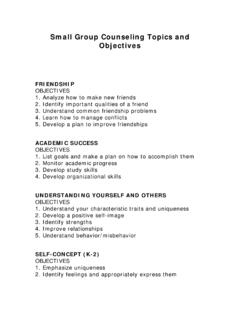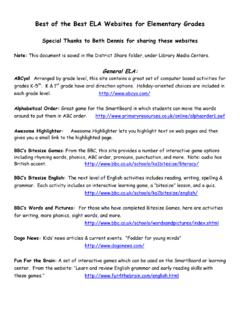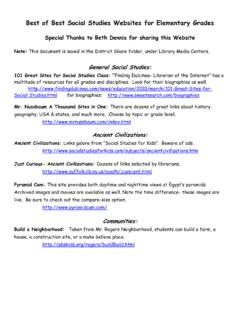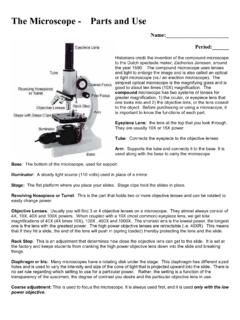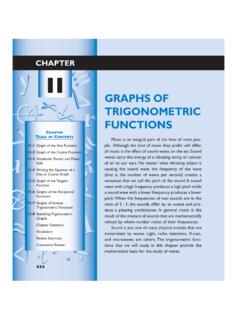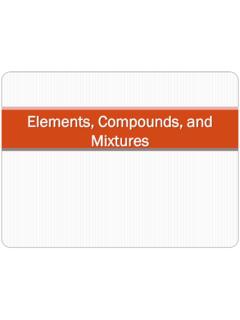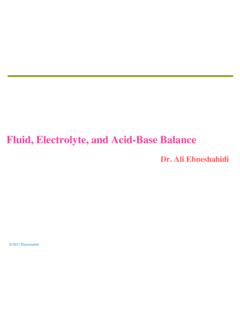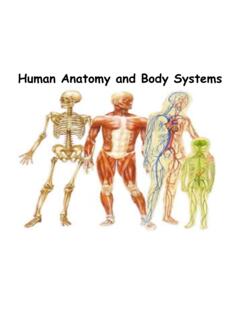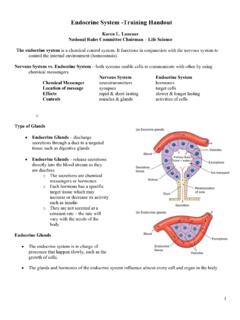Transcription of Human Body Systems - Plainview
1 Human Body SystemsRegulation and Homeostasis in the Human Body:Quick view Eleven Body Systems work together to maintain homeostasis. 1. Nervous System 2. Endocrine System 3. Lymphatic System 4. Circulatory System5. Respiratory System6. Digestive System 7. Excretory System8. Skeletal System 9. Muscular System 10. Integumentary System11. Reproductive System Human Body OrganizationThe Human Bodyis composed ofOrgan Systemsare composed ofOrgansare composed ofTissuesare composed ofCellsWhat is the job of your circulatory system? To transport oxygenand nutrientsaround your body and to help to get rid of wastesWhat organs, or parts, make up your circulatory system? Arteries Veins Heart Blood The heart pumps blood through Of Blood VesselsArteriesMove blood awayfrom heartHave thick & elasticwalls, made of smooth connected to ventriclesin the Of Blood VesselsVeinsMove blood toward the heartHave squeezed by blood with waste materialsand that is Of Blood VesselsCapillariesAre microscopicblood arteriesto walls are only one cellthick!
2 Nutrientsand oxygenare exchanged from the blood to body cells through capillary blood cellRed blood cellParts of Human BloodHelp fight infectionHelp clot bloodContains nutrients & minerals The liquid part of bloodTransport O2 White blood cellsRed blood cellsPlateletsPlasmaDigestive SystemFunction:Digestion is the process of breaking food into small molecules so that they can be absorbed and used by the Are substances in food that provide energyand materials for cell development, growth, and Digestive SystemFunction:to change food into simpler molecules that can be absorbed into bloodstream and used by the bodyMajor Organs : Organs that food will pass throughMouthEsophagusStomachSmall intestine Large intestineThe Digestive SystemPurpose:to change food into simpler molecules that can be absorbed into bloodstream and used by the bodyMajor Organs : Organs that food will pass throughMouthEsophagusStomachSmall intestine Large intestine1) MOUTH2) ESOPHAGUS3) STOMACH4) SMALL INTESTINE5) LG.
3 INTESTINE6) RECTUMLIVERGALL BLADDERPANCREASMAIN ORGANSHELPER ORGANS1) MOUTH2) ESOPHAGUS3) STOMACH4) SMALL INTESTINE5) LG. INTESTINE6) RECTUMLIVERGALL BLADDERPANCREASMAIN ORGANSHELPER ORGANSYour Digestive SystemEsophagus: muscular tubethat connects throat to stomach. Moves food down by squeezing (peristalsis)ESOPHAGUSYour Digestive SystemStomach: muscular bagwhere chemical and mechanical digestion continue; food stays here ~4 hours, changes to chymeSTOMACHS mall Intestine: Tube nearly 7 meterslong where digestive juices from liver and pancreasare added villiabsorb small nutrient molecules. All chemical and physical digestion ENDSS mall IntestineVILLIS mall IntestineVillusSection 38-2 The small intestine absorbs nutrients and transfers the nutrients to the circulatory system. The small intestine is lined with small fingerlike projections known as villiwhich designed to have a large surface area for this task.
4 Large Intestine: absorbs water from undigested food, where unabsorbed materials become more solidRectum: where solid wastes (feces) are : muscles controlthe release of solid wastesfrom the bodyRECTUMR espiratory SystemMajor Structures lungs, nose, mouth, tracheaFunctions moves air into and out of lungs; controls gas exchange between blood and lungsSection 37-3 Figure 37-13 The Respiratory SystemBronchi branch to air sacs known as aveoli where gas exchange occursThe Respiratory Systemlinks to the Circulatory Systemto provide cells with oxygen and remove carbon dioxideAlveoliBronchioleCapillarySection 37-3 Gas Exchange in the lungs occurs through the process ofDIFFUSIONHigh concentration of oxygen (O2) moves out of lungs into blood to balance concentration. CO2does the opposite (moves from blood to lungs)Air inhaledDiaphragmRib cage risesAir exhaledDiaphragmRib cage lowersInhalationExhalationSection 37-3 Figure 37-15 The Mechanics of BreathingThe Lungs are only air sacs.
5 In order for them to move they must work together with a muscle known as the DiaphragmExcretory SystemFunctions Removes cellular wastes from blood and the bodyMajor Structures kidneys urinary bladder ureters urethra skin, lungsWastes and water diffuse out of the blood into filters in the kidney. The kidneys form the liquid waste URINE. Urine leaves the kidneys and is passed from the ureters to the urinary bladder. KidneyUrinary BladderUreterUrethraVeinArteryHow does the Human body move from place to place and have the ability to run, blink or build things? These things are all made possible by the skeletal and muscular Systems . Muscular SystemFunction: MOVEMENTM ajor Muscle Types Skeletal Attached to bones for voluntary actions Smooth Found in the digestive tract and the blood vessels to move food and blood.
6 Control involuntary actions (you do not decide for them to work) Cardiac Heart muscle cells are involuntary. MovementMovementBiceps (relaxed)Triceps (contracted)Biceps (contracted)Triceps (relaxed)Section 36-2 Skeletal muscles work in opposing pairs. When one muscle contracts, the other relaxes. There are nearly 600 skeletal muscles that make up nearly half of the total body weight in the Human . Muscles can only pull they cannot push. Energy is stored in the muscles in a chemical called ATP. Lactic acid is released when the muscles are overworked and lack O2, making the muscles hurt or ache. Muscles are attached to bones by tendons. The biggest muscles in the body are the gluteus maximus muscles (buttocks), but the muscle that can exert the most force is the masseter (jaw muscle).
7 Skeletal SystemMajor Structures bones and jointsFunctions protects organs shapes & supports the body interacts with skeletal muscles allows for movement produces blood cells in the bone marrow stores minerals calcium and phosphorous Interesting A baby is born with 270 bones while an adult body has 206 bones. The hands and feet contain half of the bones in the Human body. Bones are made of the hard mineral calcium, living cells, blood vessels and nerves. Bones are made of several layers periosteum, compact bone, and spongy bone. A joint is where two bones meet. Joints can be fixed (the skull), ball-and-socket (shoulders and hips), pivot (neck), gliding (wrists), and hinged (fingers, elbows, and knees). Reproductive SystemFunctions produces gametes Eggs (female) Sperm (male) Allows for the continuation of the Structures ovaries, uterus, and (in females) testes and penis (in males)The Reproductive SystemFunctions to make new individuals by producing, storing and releasing specialized sex cells known as from the malereproductive system, known as sperm, must fuse with cells of the femalereproductive system, known as A person grows over 5 million times bigger changing from a single cell to a newborn Human being.
8 Humans grow for about 20 years, changing from a child to an adult. Male reproductive cells are called sperm, and female reproductive cells are called eggs. Sperm and eggs have only 23 chromosomes each. When joined together, sperm and egg make a whole cell called a zygotewhich can grow into a SystemMajor Structures brain, spinal cord, nerves, sense organsFunctions regulates behavior; maintains homeostasis; regulates other organ Systems ; controls sensory and motor functionsThe Nervous System:The nervous system is the number one communication center of the body. The basic cell type that carries the communications are neurons that transmit electrical terminalsNodesMyelin SheathCell Body NucleusDendritesNEURON CELL The nervous system is divided into two divisions: The Central Nervous System(CNS) Responsible for relaying messages, processing and analyzing information.
9 The Peripheral Nervous System Receives information from the environment and relays commands from the CNS to the organs and glandsCerebrumCerebellumMedulla oblongataBRAIN STEMThe BrainThe brain is the main switching area of the central nervous system. Cerebrum Responsible for voluntary activities of the body (Intelligence, learning and judgement)Cerebellum Coordinates muscle movement and balanceBrain Stem Consists of the ponsand the medulla oblongata. Pass message between brain and body Interesting The left half of the brain controls the right half of the body and vice-versa. The Human brain is more powerful and complicated than the world s biggest computer. It can store millions of memories and do billions of calculations every day. The Human body has over 100 billion neurons in all.
10 The brain can receive over 100,000 signals per second. Messages whiz through the nerves at up to 270 mph. Neurons reaching from the spinal cord to the toes are the longest cells in the Human body, measuring up to 4 feet in SystemFunctions: regulates body activities temperature, metabolism development, and reproduction maintains homeostasis regulates other organ systemsMajor Glands (organs): hypothalamus pituitary Pancreas Adrenal Thyroid testes and ovariesProduces hormones, chemicalsthat control the GlandsPineal GlandThyroidPancreasOvary (female)Testis (male)Endocrine Glands Endocrine glands release hormones, chemicals that act as signals telling different parts of the body what to do. The body makes over 20 hormones, each with a different job to do. The blood carries hormones around the body until reaching the target organ, the body part needing it.
